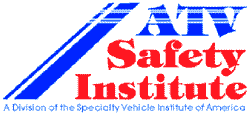
Established ATV Manufacturers Urge Congress
to Enact Legislation Making Voluntary Standards Mandatory
for all ATVs Sold in U.S.
Irvine, CA (6/5/06) - A new study
released today by the Specialty Vehicle Institute of
America revealed a host of dangerous safety problems
with youth-model all-terrain vehicles from several companies
that are new to the U.S. market. The study analyzed
four such "new entrant" ATVs and found that
each one failed to comply with the voluntary industry
standard agreed to by established ATV companies and
by the U.S. Consumer Product Safety Commission. The
study authors concluded that three of the four ATVs
suffered from severe safety issues and may constitute
a Substantial Product Hazard under U.S. law, subject
to a CPSC recall. Hazards included inadequate brakes
and suspension, no lockout to prevent starting while
in gear, and top speeds beyond the limits established
for youth models.
All of the problem ATVs are targeted to the youth market
and are readily available over the Internet or at various
retailers not traditionally associated with powersports
products.
The SVIA commissioned the report, authored by two former
U.S. CPSC experts
at the firm Marchica & Deppa, to analyze four ATVs
manufactured by new entrant companies.
The four ATVs do not comply with ANSI/SVIA-1-2001 American
National Standard for Four Wheel All-Terrain Vehicles
- Equipment, Configuration, and Performance Requirement,
nor with the voluntary agreement between the CPSC and
that established ATV companies who are members of SVIA.
SVIA President Tim Buche will discuss the study as
part of his testimony at a June 6 Senate Commerce, Science
and Transportation Subcommittee Hearing on "Compliance
with All-Terrain Vehicle Standards," chaired by
Sen. George Allen, R-Va.
"This report confirms our worst fears, new entrants
to the U.S. market that don't comply with the voluntary
safety standards established ATV companies adhere to
are jeopardizing the safety of young riders," said
SVIA President Tim Buche. "These new entrants now
comprise 20 percent of the market and are undercutting
the safety programs developed by established ATV companies.
We urge Congress to enact legislation to make the voluntary
industry standards, responsible sales practices and
the offer of free training with purchase mandatory for
any ATV sold in the United States."
The study was commissioned to examine and test the
new entrant ATVs for compliance with the ANSI/SVIA-1-2001
standard, and to determine the extent to which the new
entrant companies are providing proper product safety
information, warnings, training and product support.
The ATVs tested were all youth- or small-sized vehicles
intended for use by children under age 16.
"The four new entrant ATVs we tested pose a serious
safety risk to consumers," said Nick Marchica,
co-author of the study and the former project manager
for the CPSC's Product Safety Assessment in the Office
of Compliance. "We found a variety of serious safety
violations. Two of the ATVs lacked front brakes. Two
had inadequate suspension systems or none at all. Two
can be started in gear.
"We determined that two of the smallest ATVs sold
for use by young children were so unsafe that we refused
to allow our youth test operators to ride them,"
Marchica said. "The high speed, poor brakes and
suspension systems of these products were deemed too
potentially dangerous."
Marchica & Deppa chose the four new entrant ATVs
from the Internet. Three were purchased by phone and
delivered directly to the home of one of the partners.
The four ATVs purchased included a Baja Motorsports
90cc, a Kazuma Meerkat 50cc, Sun L SLA-90cc, and a Long
Chang Lion S 110cc. The authors analyzed the four ATVs
in accordance with the requirements of the ANSI/SVIA-1-2001
standard. The vehicles were delivered without having
been properly set up and adjusted, including potentially
hazardous assembly omissions and tires inflated to five
or six times over the recommended pressures - which
is another serious safety problem.
"SVIA has contacted many new entrants, provided
complimentary copies of the standard, and encouraged
SVIA membership and participation in the safety programs
offered by the more established ATV companies,"
Buche said. "Their disregard for consumer safety
could seriously undermine the current government and
industry efforts to enhance ATV safety, and leave the
government no choice but to mandate compliance with
the voluntary
standards."
For further information on the report contact SVIA
media relations.
About the ATV Safety Institute
The All-Terrain Vehicle Safety Institute(R),
a not-for-profit division of the Specialty Vehicle Institute
of America(R), was formed in 1988 to implement an expanded
national program of all-terrain vehicle safety education
and awareness. The ATV Safety Institute's primary goal
is to promote the safe and responsible use of ATVs,
thereby reducing accidents and injuries that may result
from improper ATV operation by the rider. For safety
information or to enroll in the ATV RiderCourse(SM)
nearest you, visit www.atvsafety.org
and click on "Online Enrollment," or call
800.887.2887.

ATV
Safety Institute
800.887.2887
Discuss
this in ATVriders.com Forum
| 













